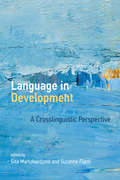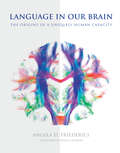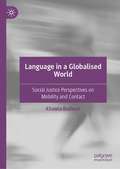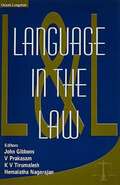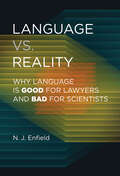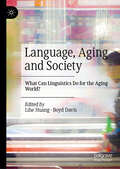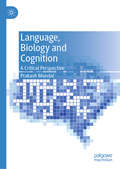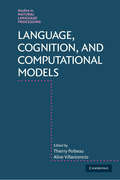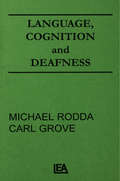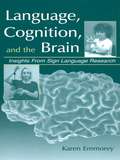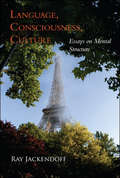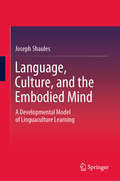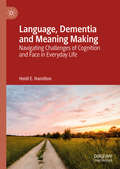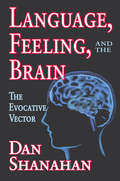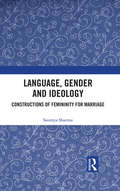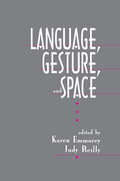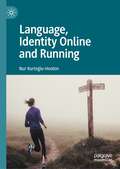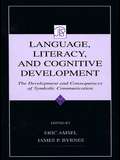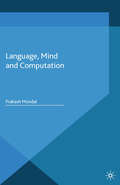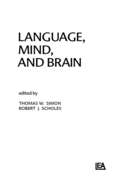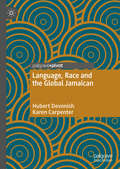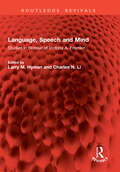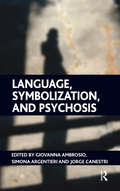- Table View
- List View
Language in Development: A Crosslinguistic Perspective
by Edited by Gita Martohardjono and Suzanne FlynnExplorations of language development in different types of learner populations and across various languages.This volume examines language development in different types of learner populations and across various languages. The contributors analyze experimental studies of child and adult language acquisition, heritage language development, bilingualism, and language disorders. They consider theoretical and methodological issues; language development in children, discussing topics that range from gestures to errors in person and number agreement; and development and attrition of (morpho)syntactic constructions in second language learners, bilinguals, and Alzheimer's patients. The approach is "crosslinguistic" in three senses of the word: the contributors offer analyses of acquisition phenomena in different languages; they consider "crosslinguistic influence," or the potential effects of multiple languages on one another in the mind of the same speaker; and (in a novel use of the term, proposed by the editors) the chapters bring together theoretical and methodological approaches pertinent to the linguistics of language development in children, adults, and heritage speakers.
Language in Our Brain: The Origins of a Uniquely Human Capacity (The\mit Press Ser.)
by Angela D. FriedericiA comprehensive account of the neurobiological basis of language, arguing that species-specific brain differences may be at the root of the human capacity for language.Language makes us human. It is an intrinsic part of us, although we seldom think about it. Language is also an extremely complex entity with subcomponents responsible for its phonological, syntactic, and semantic aspects. In this landmark work, Angela Friederici offers a comprehensive account of these subcomponents and how they are integrated. Tracing the neurobiological basis of language across brain regions in humans and other primate species, she argues that species-specific brain differences may be at the root of the human capacity for language.Friederici shows which brain regions support the different language processes and, more important, how these brain regions are connected structurally and functionally to make language processes that take place in milliseconds possible. She finds that one particular brain structure (a white matter dorsal tract), connecting syntax-relevant brain regions, is present only in the mature human brain and only weakly present in other primate brains. Is this the “missing link” that explains humans' capacity for language?Friederici describes the basic language functions and their brain basis; the language networks connecting different language-related brain regions; the brain basis of language acquisition during early childhood and when learning a second language, proposing a neurocognitive model of the ontogeny of language; and the evolution of language and underlying neural constraints. She finds that it is the information exchange between the relevant brain regions, supported by the white matter tract, that is the crucial factor in both language development and evolution.
Language in a Globalised World: Social Justice Perspectives on Mobility and Contact
by Khawla BadwanThis book takes a critical look at the role of language in an increasingly diversified and globalised world, using the new framework of 'sociolinguistics of globalisation' to draw together research from human geography, sociolinguistics, and intercultural communication. It argues that globalisation has resulted in a destabilisation of social and linguistic norms, and presents a ‘language-in-motion’ approach which addresses the inequalities and new social divisions brought by the unprecedented levels of population mobility. This book looks at language on the individual, national and transnational level, and it will be of interest to readers with backgrounds in history, politics, human geography, sociolinguistics and minority languages.
Language in the Law
by John Carey V. Prakasam John Gibbons K. V. TirumaleshThe Language in the Law records the different modes and practices in the use of language related to law. The nexus between language and the law in various countries and cultures is examined in this book.
Language vs. Reality: Why Language Is Good for Lawyers and Bad for Scientists
by N.J. EnfieldA fascinating examination of how we are both played by language and made by language: the science underlying the bugs and features of humankind&’s greatest invention.Language is said to be humankind&’s greatest accomplishment. But what is language actually good for? It performs poorly at representing reality. It is a constant source of distraction, misdirection, and overshadowing. In fact, N. J. Enfield notes, language is far better at persuasion than it is at objectively capturing the facts of experience. Language cannot create or change physical reality, but it can do the next best thing: reframe and invert our view of the world. In Language vs. Reality, Enfield explains why language is bad for scientists (who are bound by reality) but good for lawyers (who want to win their cases), why it can be dangerous when it falls into the wrong hands, and why it deserves our deepest respect. Enfield offers a lively exploration of the science underlying the bugs and features of language. He examines the tenuous relationship between language and reality; details the array of effects language has on our memory, attention, and reasoning; and describes how these varied effects power narratives and storytelling as well as political spin and conspiracy theories. Why should we care what language is good for? Enfield, who has spent twenty years at the cutting edge of language research, argues that understanding how language works is crucial to tackling our most pressing challenges, including human cognitive bias, media spin, the &“post-truth&” problem, persuasion, the role of words in our thinking, and much more.
Language, Aging and Society: What Can Linguistics Do for the Aging World?
by Lihe Huang Boyd DavisThis book explores how studies of language and aging can be applied to build an aging-friendly society, drawing on the socio-pragmatic turn in language and aging to examine the perspectives of older adults experiencing aging through a linguistic lens. Research on the phenomenon and mechanisms of language in aging can provide older adults with language training, increase their active aging, and offer improved information communication channels for an aging society, which will bring a series of clinical and social benefits to handle problems in aging and language across the world. This book will be of interest to researchers in linguistics, sociology, gerontology and related fields.
Language, Biology and Cognition: A Critical Perspective
by Prakash MondalThis book examines the relationship between human language and biology in order to determine whether the biological foundations of language can offer deep insights into the nature and form of language and linguistic cognition. Challenging the assumption in biolinguistics and neurolinguistics that natural language and linguistic cognition can be reconciled with neurobiology, the author argues that reducing representation to cognitive systems and cognitive systems to neural populations is reductive, leading to inferences about the cognitive basis of linguistic performance based on assuming (false) dependencies. Instead, he finds that biological implementations of cognitive rather than the biological structures themselves, are the driver behind linguistic structures. In particular, this book argues that the biological roots of language are useful only for an understanding of the emergence of linguistic capacity as a whole, but ultimately irrelevant to understanding the character of language. Offering an antidote to the current thinking embracing ‘biologism’ in linguistic sciences, it will be of interest to readers in linguistics, the cognitive and brain sciences, and the points at which these disciplines converge with the computer sciences.
Language, Cognition, and Computational Models (Studies in Natural Language Processing)
by Aline Villavicencio Thierry PoibeauHow do infants learn a language? Why and how do languages evolve? How do we understand a sentence? This book explores these questions using recent computational models that shed new light on issues related to language and cognition. The chapters in this collection propose original analyses of specific problems and develop computational models that have been tested and evaluated on real data. Featuring contributions from a diverse group of experts, this interdisciplinary book bridges the gap between natural language processing and cognitive sciences. It is divided into three sections, focusing respectively on models of neural and cognitive processing, data driven methods, and social issues in language evolution. This book will be useful to any researcher and advanced student interested in the analysis of the links between the brain and the language faculty.
Language, Cognition, and Deafness
by Michael Rodda Carl GroveFirst published in 1987. Routledge is an imprint of Taylor & Francis, an informa company.
Language, Cognition, and the Brain: Insights From Sign Language Research
by Karen EmmoreyOnce signed languages are recognized as natural human languages, a world of exploration opens up. Signed languages provide a powerful tool for investigating the nature of human language and language processing, the relation between cognition and language, and the neural organization of language. The value of sign languages lies in their modality. Specifically, for perception, signed languages depend upon high-level vision and motion processing systems, and for production, they require the integration of motor systems involving the hands and face. These facts raise many questions: What impact does this different biological base have for grammatical systems? For online language processing? For the acquisition of language? How does it affect nonlinguistic cognitive structures and processing? Are the same neural systems involved? These are some of the questions that this book aims at addressing. The answers provide insight into what constrains grammatical form, language processing, linguistic working memory, and hemispheric specialization for language. The study of signed languages allows researchers to address questions about the nature of linguistic and cognitive systems that otherwise could not be easily addressed.
Language, Consciousness, Culture: Essays on Mental Structure (Jean Nicod Lectures)
by Ray S. JackendoffAn integrative approach to human cognition that encompasses the domains of language, consciousness, action, social cognition, and theory of mind that will foster cross-disciplinary conversation among linguists, philosophers, psycholinguists, neuroscientists, cognitive anthropologists, and evolutionary psychologists.Ray Jackendoff's Language, Consciousness, Culture represents a breakthrough in developing an integrated theory of human cognition. It will be of interest to a broad spectrum of cognitive scientists, including linguists, philosophers, psycholinguists, neuroscientists, cognitive anthropologists, and evolutionary psychologists.Jackendoff argues that linguistics has become isolated from the other cognitive sciences at least partly because of the syntax-based architecture assumed by mainstream generative grammar. He proposes an alternative parallel architecture for the language faculty that permits a greater internal integration of the components of language and connects far more naturally to such larger issues in cognitive neuroscience as language processing, the connection of language to vision, and the evolution of language.Extending this approach beyond the language capacity, Jackendoff proposes sharper criteria for a satisfactory theory of consciousness, examines the structure of complex everyday actions, and investigates the concepts involved in an individual's grasp of society and culture. Each of these domains is used to reflect back on the question of what is unique about human language and what follows from more general properties of the mind.Language, Consciousness, Culture extends Jackendoff's pioneering theory of conceptual semantics to two of the most important domains of human thought: social cognition and theory of mind. Jackendoff's formal framework allows him to draw new connections among a large variety of literatures and to uncover new distinctions and generalizations not previously recognized. The breadth of the approach will foster cross-disciplinary conversation; the vision is to develop a richer understanding of human nature.
Language, Culture, and the Embodied Mind: A Developmental Model of Linguaculture Learning
by Joseph ShaulesThere is an odd contradiction at the heart of language and culture learning: Language and culture are, so to speak, two sides of a single coin—language reflects the thinking, values and worldview of its speakers. Despite this, there is a persistent split between language and culture in the classroom. Foreign language pedagogy is often conceptualized in terms of gaining knowledge and practicing skills, while cultural learning goals are often conceptualized in abstract terms, such as awareness or criticality.This book helps resolve this dilemma. Informed by brain and mind sciences, its core message is that language and culture learning can both be seen as a single, interrelated process—the embodiment of dynamic systems of meaning into the intuitive mind. This deep learning process is detailed in the form of the Developmental Model of Linguaculture Learning (DMLL). Grounded in dynamic skill theory, the DMLL describes four developmental levels of language and culture learning, which represents a subtle, yet important shift in language and culture pedagogy. Rather than asking how to add culture into language education, we should be seeking ways to make language and culture learning deeper—more integrated, embodied, experiential and transformational. This book provides a theoretical approach, including practical examples, for doing so.
Language, Dementia and Meaning Making: Navigating Challenges of Cognition and Face in Everyday Life
by Heidi E. HamiltonThis book investigates the ways in which context shapes how cognitive challenges and strengths are navigated and how these actions impact the self-esteem of individuals with dementia and their conversational partners. The author examines both the language used and face maintenance in everyday social interaction through the lens of epistemic discourse analysis. In doing so, this work reveals how changes in cognition may impact the faces of these individuals, leading some to feel ashamed, anxious, or angry, others to feel patronized, infantilized, or overly dependent, and still others to feel threatened in both ways. It further examines how discursive choices made by healthy interactional partners can minimize or exacerbate these feelings. This path-breaking work will provide important insights for students and scholars of sociolinguistics, applied linguistics, medical anthropology, and health communication.
Language, Feeling, and the Brain: The Evocative Vector
by Daniel ShanahanLinguistic theory since the Cognitive Revolution has fol- lowed one of the premises of that revolution by largely sidelining the issue of emotions and concentrating on those aspects of language that are more strictly cognitive. However, during the last ten years research in cognitive science, especially in neuropsychology, has begun to fill in the gaps left by the exclusion of emotions from cognitive research. The work of those like Oatley, Zajonc, Damasio, and LeDoux, to name a few, has demonstrated both that it is possible to construct models of how emotions play into the workings of the psyche and that they are necessary in giving us a balanced view of the human mind. Language, Feeling, and the Brain attempts to apply the fruits of this new research in emotion to our understanding of language itself. Building on Karl Pribram's integrated model of emotions and motivations, the book takes an eclectic approach to explaining how emotions contribute to the nature of language, drawing on research done in neuropsychology, philosophy, cognitive linguistics, anthropology, and related fields. Its aim is to construct a propositional model for how the emotions may have contributed to the emergence of symbolic formation, most especially in the forms of gesture and speech, and how identifying that emotional influence sheds new light on everything we have had to say about language itself, from lexis and grammar to culture and literature.
Language, Gender and Ideology: Constructions of Femininity for Marriage
by Saumya SharmaThis book explores multiple facets of femininity for marriage in India. Using language as an entry point, it looks at how and why media representations of gender identities are constructed the way they are. It works with a unique synthesis of second-wave feminist discourse and empirical linguistic research to look at how the social institution of marriage becomes the site of interaction between language, ideology, psyche and culture. This volume also brings together the personal histories and views of women who discuss how media, modernity and social norms shape their ideas about marriage and selfhood. Deconstructing perceptions of femininity in contemporary India, the book will be of great interest to scholars and researchers of sociology, gender studies, linguistics, media and cultural studies and psychoanalysis.
Language, Gesture, and Space
by Karen Emmorey Judy S. ReillyThis book brings together papers which address a range of issues regarding the nature and structure of sign languages and other gestural systems, and how they exploit the space in which they are conveyed. The chapters focus on five pertinent areas reflecting different, but related research topics: * space in language and gesture, * point of view and referential shift, * morphosyntax of verbs in ASL, * gestural systems and sign language, and * language acquisition and gesture. Sign languages and gestural systems are produced in physical space; they manipulate spatial contrasts for linguistic and communicative purposes. In addition to exploring the different functions of space, researchers discuss similarities and differences between visual-gestural systems -- established sign languages, pidgin sign language (International Sign), "homesign" systems developed by deaf children with no sign language input, novel gesture systems invented by hearing nonsigners, and the gesticulation that accompanies speech. The development of gesture and sign language in children is also examined in both hearing and deaf children, charting the emergence of gesture ("manual babbling"), its use as a prelinguistic communicative device, and its transformation into language-like systems in homesigners. Finally, theoretical linguistic accounts of the structure of sign languages are provided in chapters dealing with the analysis of referential shift, the structure of narrative, the analysis of tense and the structure of the verb phrase in American Sign Language. Taken together, the chapters in this volume present a comprehensive picture of sign language and gesture research from a group of international scholars who investigate a range of communicative systems from formal sign languages to the gesticulation that accompanies speech.
Language, Identity Online and Running
by Nur Kurtoğlu-HootonThis book focuses on language and identity online within the context of running from an interdisciplinary perspective. It brings together digital ethnography, existential phenomenology, interpretative phenomenological analysis and sporting embodiment in the pursuit to explore runners’ lived experiences and identities online. Language, identity and identity online are often studied in broader social contexts such as education, culture and politics, and running is intimately related to key issues in contemporary society, such as health and exercise, sport and nationalism, embracing a variety of discourse types and having implications more generally for our identity as human beings. The evolving online media through which people make sense of who they are and which groups they belong to are enabling new ways of realising identities and relationships. This book will be of interest to applied linguists, discourse analysts, as well as those interested in sports, sports psychology, and identity enactment.
Language, Literacy, and Cognitive Development: The Development and Consequences of Symbolic Communication (Jean Piaget Symposia Series)
by Eric Amsel James P. ByrnesLanguage, Literacy, and Cognitive Development addresses the impact of language and literacy on cognitive development. Top researchers examine the cognitive significance of the growth in children's ability to express themselves symbolically, whether that involves communicating linguistically, mathematically, logically, or through some other symbol system expressed in speech, gesture, notations, or some other means. The book contributes to refining and answering questions regarding the nature, origin, and development of symbolic communication in all its forms, and their consequences for the cognitive development of the younger child at home and the older child at school.
Language, Memory, and Thought
by John R. AndersonPublished in 1976, Language, Memory, and thought is a valuable contribution to the field of Cognitive Psychology. This book presents a theory about human cognitive functioning, a set of experiments testing that theory, and a review of some of the literature relevant to the theory. The theory is embodied in a computer simulation model called ACT.
Language, Mind and Computation
by Prakash MondalThis book explores how and in what ways the relationship between language, mind and computation can be conceived of, given that a number of foundational assumptions about this relationship remain unacknowledged in mainstream linguistic theory, yet continue to be the basis of theoretical developments and empirical advances.
Language, Mind, and Brain
by Thomas W. Simon and Robert J. ScholesThe chapters in this volume are extended versions of material first presented at the National Interdisciplinary Symposium on Language, Mind, and Brain held April 6-9, 1978, in Gainesville, Florida. Importantly for interdisciplinary goals, the papers contained in this volume are quite “ available” ; that is, papers by philosophers can easily be read and understood by linguists and psychologists; the ideas of the linguists are readily comprehensible to any educated reader; the psychologists and neurologically oriented writers are clear and nderstandable. It is, then, a volume that cuts, not so much across disciplines, but through them. First published in 1982. Routledge is an imprint of Taylor & Francis, an informa company.
Language, Race and the Global Jamaican
by Karen Carpenter Hubert DevonishThis book examines the racial and socio-linguistic dynamics of Jamaica, a majority black nation where the dominant ideology continues to look to white countries as models, yet which continues to defy the odds. The authors trace the history of how a nation of less than three million people has come to be at the centre of cultural, racial and linguistic influence globally; producing a culture than has transformed the way that the world listens to music, and a dialect that has formed the lingua franca for a generation of young people. The book will be of particular interest to students and scholars of Caribbean linguistics, Africana studies, diaspora studies, sociology of language and sociolinguistics more broadly.
Language, Sex and Social Structure
by Jodie ClarkThis book offers an innovative way of doing critical discourse analysis that focuses on the performatively produced concepts and social structures that support oppressive attitudes in a community. It draws upon ethnographic data from a women's field hockey club to examine players' homophobic attitudes towards lesbians on the team.
Language, Speech and Mind: Studies in Honour of Victoria A. Fromkin (Routledge Revivals)
by Charles N. Li Larry M. HymanFirst published in 1988, Language, Speech and Mind consists of 18 specially invited contributions to mark Professor Fromkin’s 65th birthday in 1988. It reflects her very special interdisciplinary interests and flair, thereby celebrating her own important contributions in the areas of phonetics, phonology, neurolinguistics, psycholinguistics, and the philosophy of science.
Language, Symbolization, and Psychosis: Essays In Honour Of Jacqueline Amati Mehler
by Jorge Canestri Giovanna Ambrosio Simona ArgentieriIn this book, the authors compare different psychoanalytic thinking and models – all of a rigorously Freudian stamp – on three concepts of great theoretical and clinical importance: language, symbolization, and psychosis.
